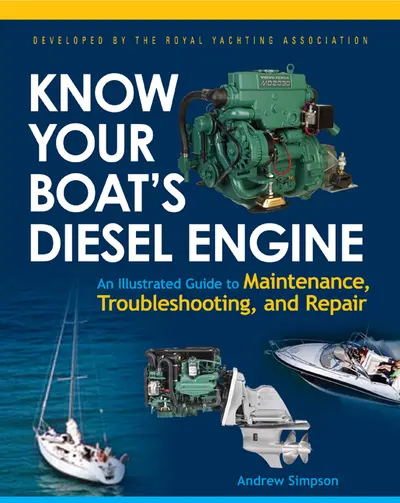My Account Details

ISBN10: 0071493433 | ISBN13: 9780071493437

Step 1 . Download Adobe Digital Editions to your PC or Mac desktop/laptop.
Step 2. Register and authorize your Adobe ID (optional). To access your eBook on multiple devices, first create an Adobe ID at account.adobe.com. Then, open Adobe Digital Editions, go to the Help menu, and select "Authorize Computer" to link your Adobe ID.
Step 3. Open Your eBook. Use Adobe Digital Editions to open the file. If the eBook doesn’t open, contact customer service for assistance.
The Diesel Engine Manual for the Rest of Us If you were surprised to learn that your boat’s engine has no spark plugs, you’re not alone. If you’re like the rest of us, you want to know how your engine works and how to keep it working, but you haven’t come across a simple, nontechnical treatment of the subject. Until now, that is. Designed especially for non-mechanically inclined boatowners, Know Your Boat's Diesel Engine is clear, direct, and richly illustrated to show you what your engine’s components look like and how they work. Developed by the Royal Yachting Association--whose seamanship courses are considered the worldwide gold standard for boating education--the book has been fully revised and adapted for North American boatowners. You’ll find: Simple yet complete information on how your engine works and the half-dozen things to check first when it fails to work as it should Easy-to-follow, step-by-step instructions for troubleshooting, maintenance, and repairs Everything powerboaters and diesel-auxiliary sailboat owners need to know to use their engines with confidence
Introduction
1. How Diesel Engines Work
The Four-Stroke Cycle
Turbocharging
Aftercooling or Intercooling?
The Two-Stroke Cycle
Direct and Indirect Injection
2. The Fuel System
What Is Diesel Fuel?
The Basic Fuel System
The Tank • Diesel "Bugs" • The Ideal Tank • Water-Separating Filter (Pre-Filter) • Fuel Lift Pump • Fine Filter (Secondary Filter)
The Injection Process
Common Rail Systems
3. The Air System
Air Filters
Exhaust
Siphon Breaks • Watertrap Silencers • Exhaust Temperature Alarms
4. The Engine Cooling System
Raw-Water Cooling
Indirect Cooling (Heat Exchanger)
Keel CoolingParts of the Cooling System
Thermostats • Seacocks and Strainers • A Pair of Pumps
5. The Electrical System
Electrical Circuits
Ground Return • Insulated Return
Alternators
Better Charging
Types of Batteries
Engine Starting
Stopping the Engine
6. The Lubrication System
What Is Lubricating Oil?
Oil Filters
Oil Pump
Gearbox Lubrication
Oil Coolers
7. The Transmission and Drive Train
Direct Drive via Gearbox, Shaft, and Propeller
Gearboxes • Shaft Couplings • Stuffing Boxes • Shaft Bearings • Propellers
Integrated Drives
Stern Drives • "Pod" Systems • Sail Drives • Water Jets
8. Engine Controls
Cable Systems
Dual-Station Controls
9. Starting and Stopping Your Engine
Pre-Start Check
Starting
A Few Running Checks
Stopping the Engine
10. Troubleshooting Your Engine
The Engine Won’t Turn Over
The Engine Turns Over but Won’t Start
The Engine Runs but Exhibits Abnormal Symptoms
Smoke Signals • Shake, Rattle, and Roll • General Lack of Performance • The Engine Hunts or Dies • Overheating Alarm Sounds • Oil Warning Light or Alarm Activated • Alternator Charge Alarm Sounds
11. Maintaining Your Engine
Basic Maintenance Intervals
Daily When in Use • Weekly When in Use • Annually
As Recommended by the Engine Manufacturer
Scheduled by the Seasons
Winterizing • Once Spring Has Sprung
Tools
Mechanical Toolkit • Electrical Toolkit
Spares
Electrical Spares
12. Critical Procedures and How to Do Them
Take Care of Your Fuel Filters
Draining a Watertrap • Replacing Filter Elements • Cartridge-Type Filters • Replaceable-Element Filters • Spin-On Filters
Bleeding the Fuel System
Changing the Oil and Filter
Extracting the Old Oil • Replacing the Filter • Refill the Oil
Changing Gearbox Oil
Changing or Adjusting the Alternator Belt
Adjusting a Packed Gland
Repacking a Stern Gland
Changing a Thermostat
Testing a Thermostat
Renewing the Freshwater Coolant
Replacing the Raw-Water Pump Impeller
Adjusting Valve Clearance
Battery Maintenance
Replacing Engine Anodes
Care of Air Filters
13. Emergency Procedures
Engine Overheats because of Thermostat Failure
Bypassing the Ignition Switch or Solenoid
Stopping a “Runaway” Engine
Dealing with an Engine Fire
Index
Need support? We're here to help - Get real-world support and resources every step of the way.